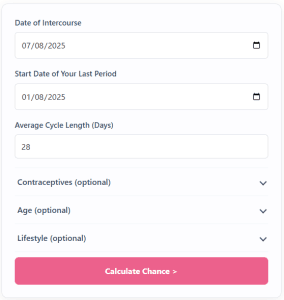Enter the date and details of one encounter to see a research-based estimate of your pregnancy chance for that single event. The result is a statistical model, not a diagnosis.
This calculator shows a statistical estimate based on research averages and the details you enter. It cannot confirm pregnancy, rule out pregnancy, or replace advice from your own clinician.
How to Use the Calculator
- Enter the start date of your most recent menstrual period.
- Provide your average menstrual cycle length (typically around 28 days).
- Enter the date of intercourse.
- Select your contraceptive method (if any) from the provided list.
- Optionally, provide additional information such as age, height, weight, weekly work hours, cigarette consumption, and alcohol intake for a more precise calculation.
- Click Calculate to view your personalized pregnancy chance.

How It Works: The Science Behind Your Estimate
The One-Time Pregnancy Calculator uses published scientific data and established fertility research to estimate your pregnancy chance from a single act of intercourse. Here is a plain-language outline of the science behind the calculator:
Fertility Variation Within Your Menstrual Cycle
A woman's fertility varies across her menstrual cycle. Ovulation, when an egg is released from the ovary, usually occurs near the midpoint of the cycle (about day 14 in a 28 day cycle). Fertility tends to be higher around ovulation, and research suggests the most fertile day is often the day before ovulation, because sperm can survive for several days in the reproductive tract while the egg is only viable for about 12 to 24 hours after release. Fertility is generally highest in the days leading up to and including ovulation, then falls again, with the lowest chance of pregnancy usually occurring during menstruation.

The calculator estimates where you were in your menstrual cycle at the time of intercourse by using the start date of your most recent period and your average cycle length. It then applies published, cycle day based fertility rates to that position in your cycle. For example:
- Menstruation (Days 1-5): Fertility is lowest, as the uterus lining sheds, making implantation unlikely.
- Pre-Ovulatory Phase (Days 6-12): Fertility gradually increases as the body prepares for ovulation.
- Ovulation (Approximately Day 13-15): Fertility peaks significantly, as this is when an egg is released and most receptive to fertilization.
- Post-Ovulatory Phase (Days 16-28): Fertility quickly declines after ovulation, approaching minimal levels as the next period approaches.
Contraceptive Effectiveness
If you enter contraceptive methods, the calculator also considers how effective those methods are. Each contraceptive has different efficacy rates for correct (perfect) and typical use. Imperfect use, such as occasionally forgetting a pill or using a condom incorrectly, substantially reduces contraceptive effectiveness. The calculator uses these differences to give a more realistic estimate for most real world situations.
Additional Factors Influencing Fertility
Optionally, the calculator accounts for various lifestyle and health factors known to influence fertility:
- Age: Female fertility declines with age, especially after age 35, due to decreasing egg quality and quantity. Male fertility also decreases after age 40, affecting sperm quality and motility.
- BMI (Body Mass Index): Conditions that may be caused by an unusually high or low BMI can negatively impact fertility through hormonal imbalances and menstrual irregularities.
- Smoking and Alcohol Intake: Smoking reduces fertility by affecting hormone levels, egg quality, and sperm health. Alcohol consumption can disrupt menstrual cycles, ovulation, and sperm quality.
- Stress and Work Hours: Chronic stress, often associated with extended working hours, can disrupt hormonal balance and menstrual regularity, potentially reducing fertility.
By combining these evidence-based factors, the One-Time Pregnancy Calculator provides a personalised statistical estimate of your pregnancy chance from a single act of intercourse. It is still a model based on averages, so your own outcome can be higher or lower than the number you see.
Frequently Asked Questions
How accurate is this calculator?
This tool provides a statistical estimate based on large-scale population data. It is designed to match published research at a population level, but your personal chance can be higher or lower. Treat it as an educational estimate, not as a guarantee or medical certainty.
What if I had intercourse on more than one day?
This calculator is specifically for a single encounter. If you had intercourse multiple times, our Pregnancy Chance Calendar is a better tool, as it can show you your chances across your entire fertile window.
My result seems high. What should I do now?
The most reliable way to know if you are pregnant is to take a home pregnancy test. For the most accurate result, wait until the first day of your missed period. Use our Pregnancy Test Accuracy Calculator to understand the best day to test. Your result here is an estimate of chance, not a diagnosis. If you are worried or unsure what to do next, talk with a doctor, midwife, or other qualified clinician.
Medical disclaimer
The information and calculators on this site are educational tools only. They provide statistical estimates based on published research and the details you enter.
They cannot diagnose, predict what will happen for you, or replace personalized advice from a licensed health care professional who knows your full history. Always talk with your doctor, midwife, or other qualified clinician before making decisions about your health, fertility, or pregnancy.
Never ignore, avoid, or delay seeking professional medical advice because of something you read here or a result you see in a calculator. If you think you may be having a medical emergency, call 911 in the United States or your local emergency number.
